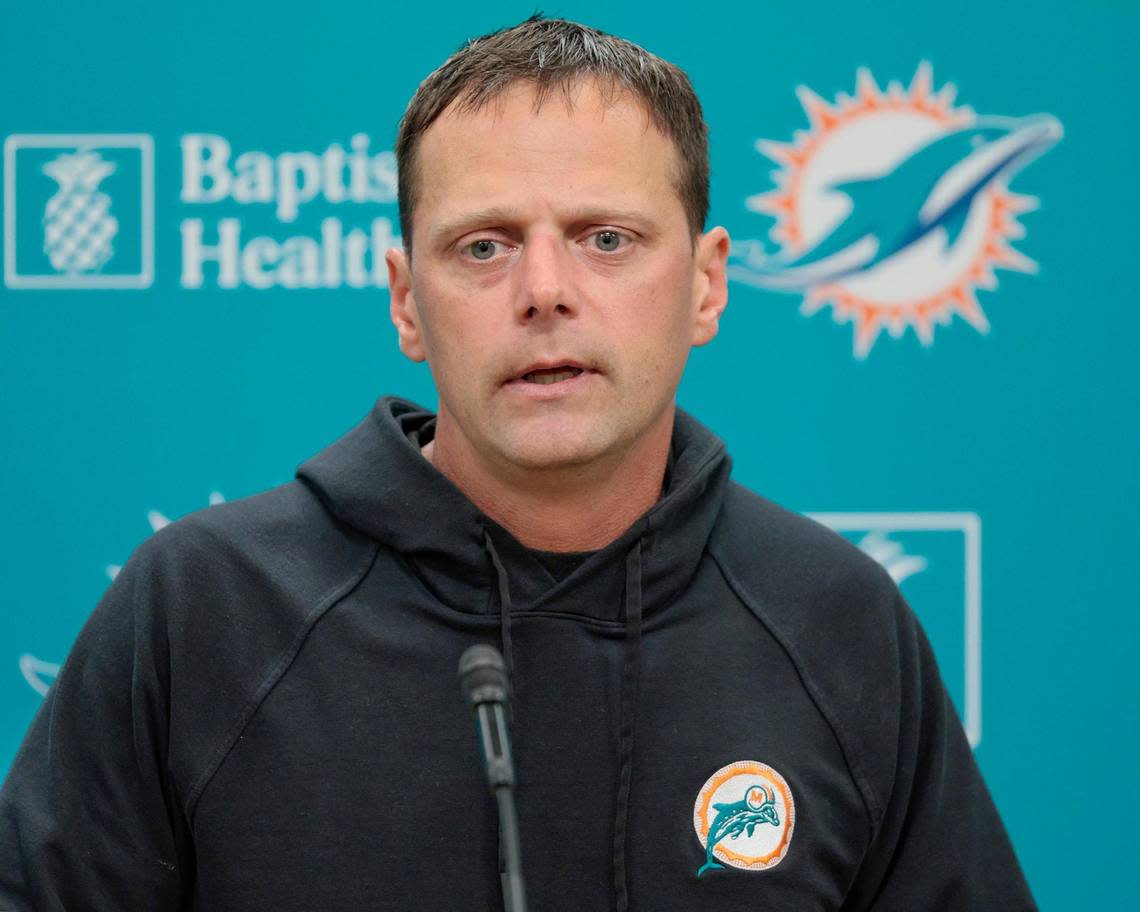With Flores gone, can Boyer sustain Dolphins defense? ‘We’ve all tried to raise the standard’
Some of Josh Boyer’s earliest memories of defensive football come from a projector. His father, Jeff, was a high school coach, and Boyer recalled the hits and players moving backward — then forward — on a screen as his dad would start and stop the video.
In the coming years, Boyer watched how offenses evolved, from the single-wing to modern concepts with spread-out formations. He also saw how that spurred changes in defenses, some of which would develop into the most dominant units in NFL history.
As the Dolphins prepare to open their 2022 season against the New England Patriots on Sunday, the potential evolution of their defense is one of the more significant subplots for a team that has playoff aspirations.
After struggling in the first half of the 2021 season, a hyperaggressive Dolphins defense sparked the team’s 8-1 finish. But gone is Brian Flores, who had his handprint on the unit in his three seasons as head coach. Boyer, who coached alongside Flores in New England for several years, was retained as defensive coordinator with the arrival of head coach Mike McDaniel.
He now has the responsibility of not only maintaining but possibly elevating the performance of the unit.
“I think each season is unique in itself,” Boyer, 45, said Thursday. “I would say we have a higher expectation as a coaching staff defensively, I would say as players defensively. I think we’ve all tried to raise the standard.”
As much uncertainty as there is about how both teams’ offenses will look on Sunday, there is a bit of mystery pertaining to a Dolphins defense that overnight seemingly transformed from one of the league’s most porous units to arguably its stingiest in the second half of last season. In the first eight games, the defense allowed close to 30 points per game. In the final nine-game stretch, that figure was cut in half and the defense gave up an average of 15 points.
However, the team’s second-half schedule was littered with backup or bottom-tier quarterbacks, prompting questions about how good the defense truly was. According to analytics site Football Outsiders, the Dolphins finished the 2021 season as the league’s 10th-most efficient defense. That standing would have dropped to an average 17th without the team’s 20-3 win over the New Orleans Saints, in which the Dolphins took advantage of their COVID-depleted opponent, sacking then-rookie Ian Book eight times in his first NFL start (Football Outsiders projects the Dolphins to have the sixth-least efficient defense in 2022).
Dolphins brass viewed the second-half surge as truly resembling the state of the defense and sought continuity amid the head coaching change. Not only was Boyer retained, but many top assistants and all 13 defensive players with at least five starts in 2021 were brought back, too.

Boyer and players were tight-lipped during the summer about potential changes. Boyer said their core philosophies would stay in place. But veteran linebacker Elandon Roberts acknowledged the team would have to pivot in some instances.
“The NFL evolves every year,” he said in August. “I expect it in all 32 teams’ defenses that everybody should evolve, and you will see little nuances in every team.”
What wrinkles could be in store? In 2021, the Dolphins blitzed on 39.6 percent of opposing dropbacks last season, second only to the Tampa Bay Buccaneers. With the aggressive approach, the defense relied on high rates of man-to-man coverage and often lined up in Cover 1 or Cover 3 schemes, in which one safety is deep in coverage.
According to Sports Info Solutions, 17 teams used two-high-safety looks — in which two safeties line up deep in coverage — on at least 50 percent of snaps, a figure that has been increasing over the years as defenses attempt to curtail the league’s passing explosion. The Dolphins, though, found success in their single-high looks and confusing quarterbacks with their blitz packages.
“They’re going to come after you. They’re going to heat you up,” said Matt Bowen, an NFL analyst for ESPN. “And the way they do that is by attacking your protection schemes, through alignment, through multiple fronts, through bringing second-level blitzers, through disguising pressures and getting the matchups they want.”
The early-season slate could test the limits of those tendencies. Cornerback Byron Jones will be sidelined for at least the first four games of the season and cornerback Nik Needham has been limited this week with a quadriceps injury. It’s unknown who of a group that also includes Noah Igbinoghene, Keion Crossen and Kader Kohou will step in as a third cornerback on Sunday.
As he scours contingency plans, Boyer also has to prepare for an offense without a known play-caller. The Patriots didn’t name a new offensive coordinator after Josh McDaniels departed, but Matt Patricia is expected to call plays. It’s a responsibility he has never held in the NFL.
“There will be an element of unknown and adjusting in the game,” Boyer said. “They may come in with a certain game plan and may completely shift it. So, that’s kind of the back and forth. ... You’ve got to be very careful of chasing ghosts because we’ve almost had seven months to game plan one game.”
Regardless, Bowen expects Boyer to call plays and operate with the skill set of his players in mind. And with a Pro Bowl cornerback in Xavien Howard still in place, a breakout candidate in safety Jevon Holland and a deep defensive front, Bowen doesn’t anticipate they’ll be much change from last season.
“I still think at the end of the day, when we get to Week 18,” Bowen said, “Miami will be one of the teams that plays the highest percentage of Cover-1, Miami will be one of the teams that brings the highest percentage of pressure. Because that fits their defensive profile. That fits their personnel.”
